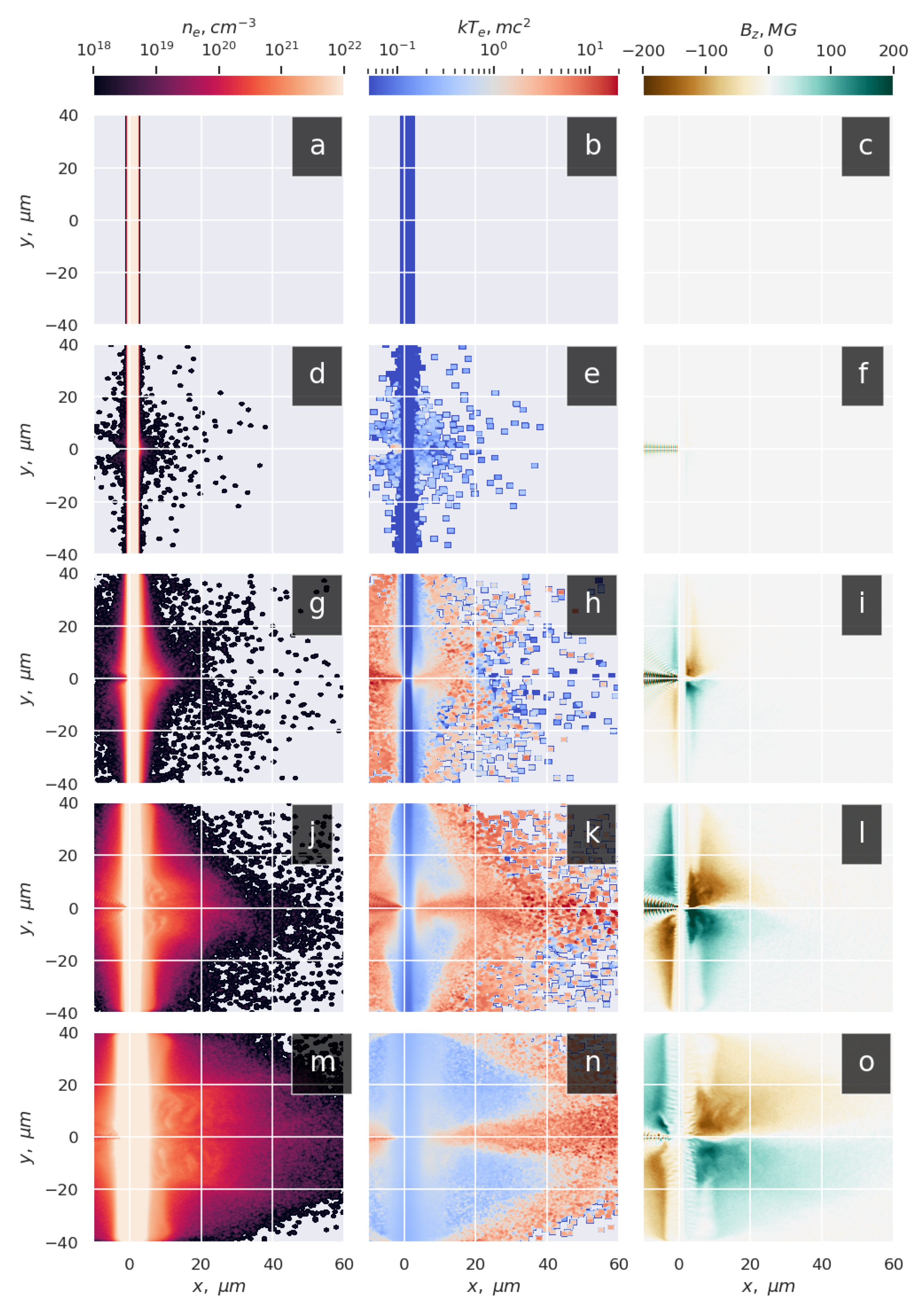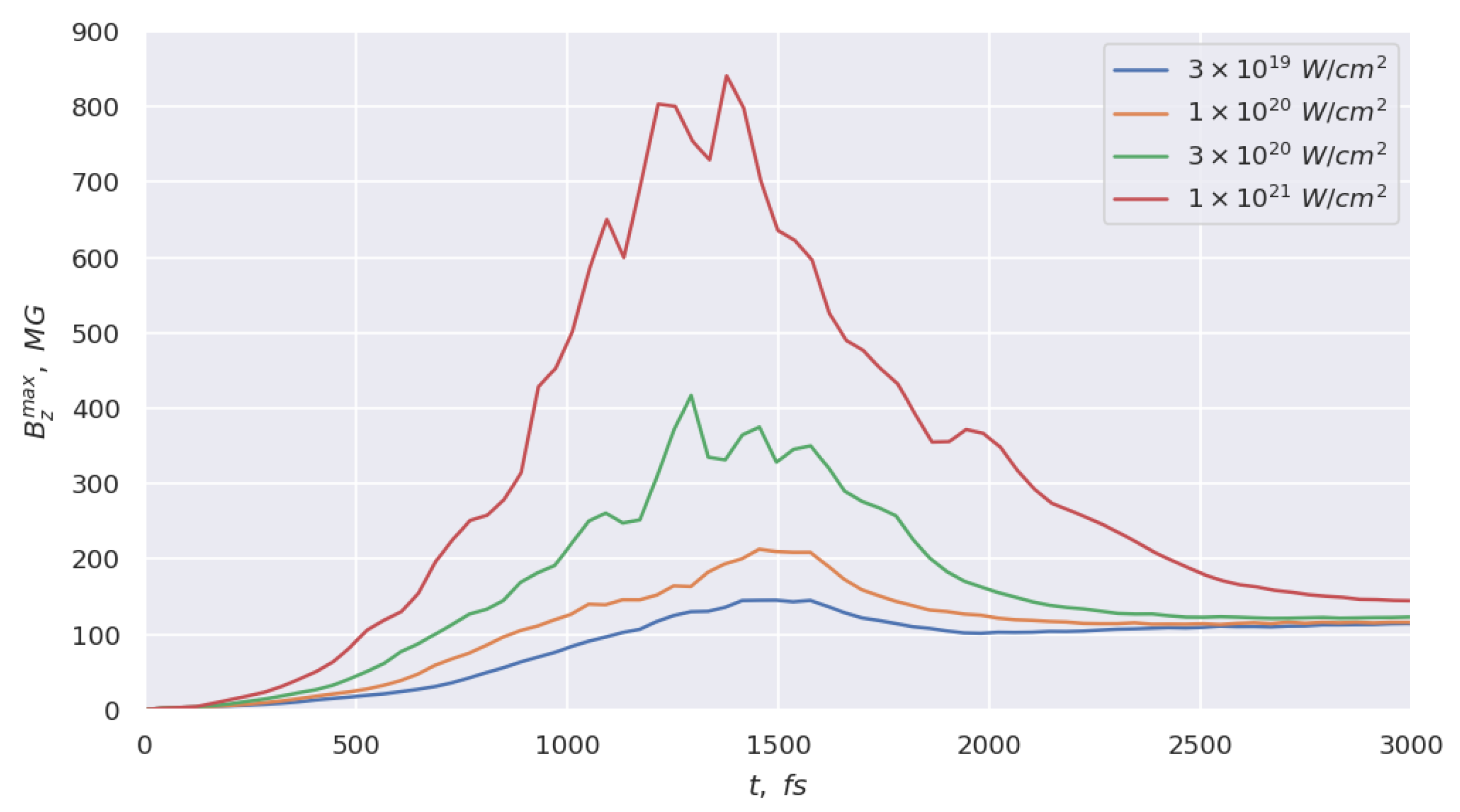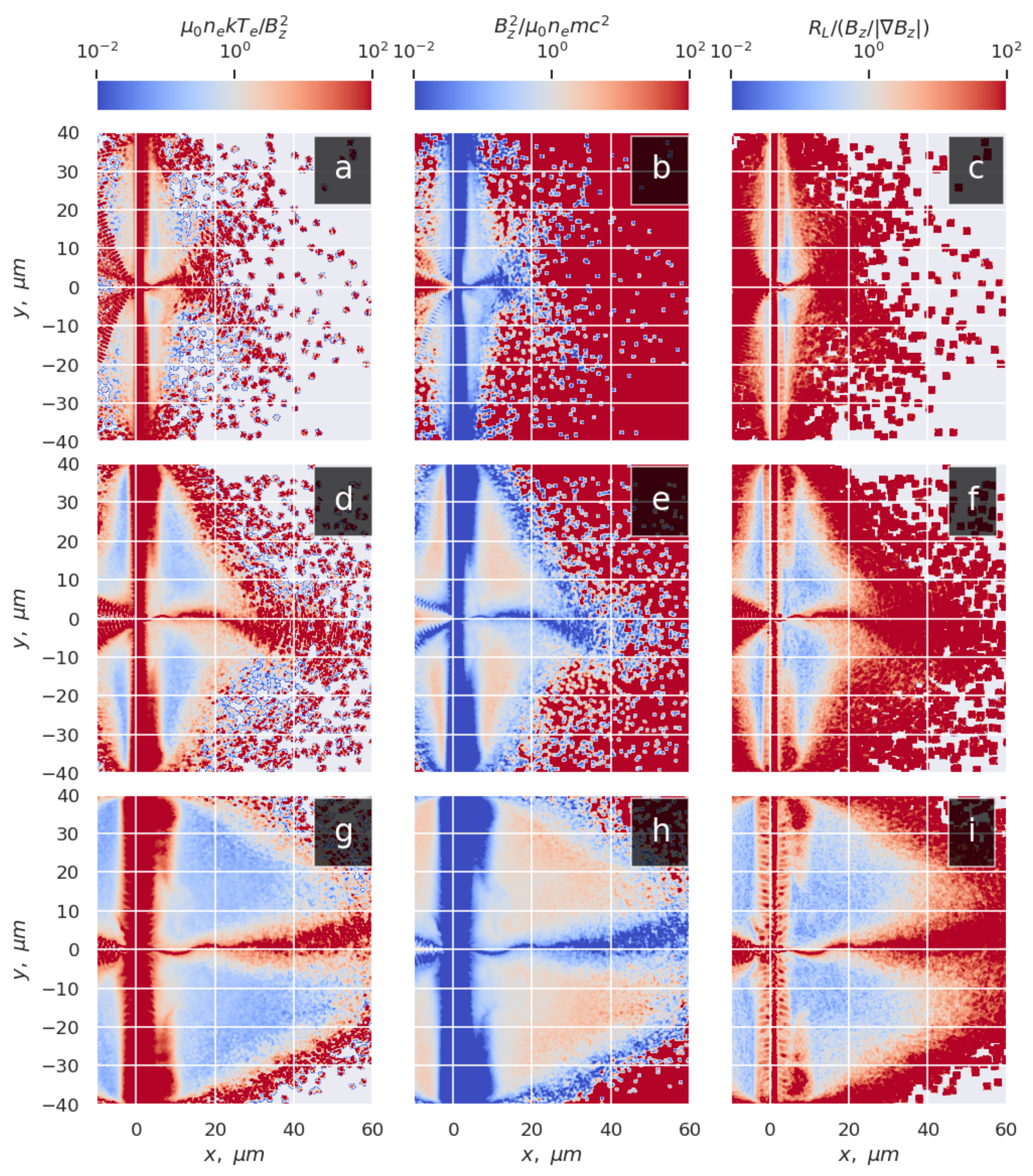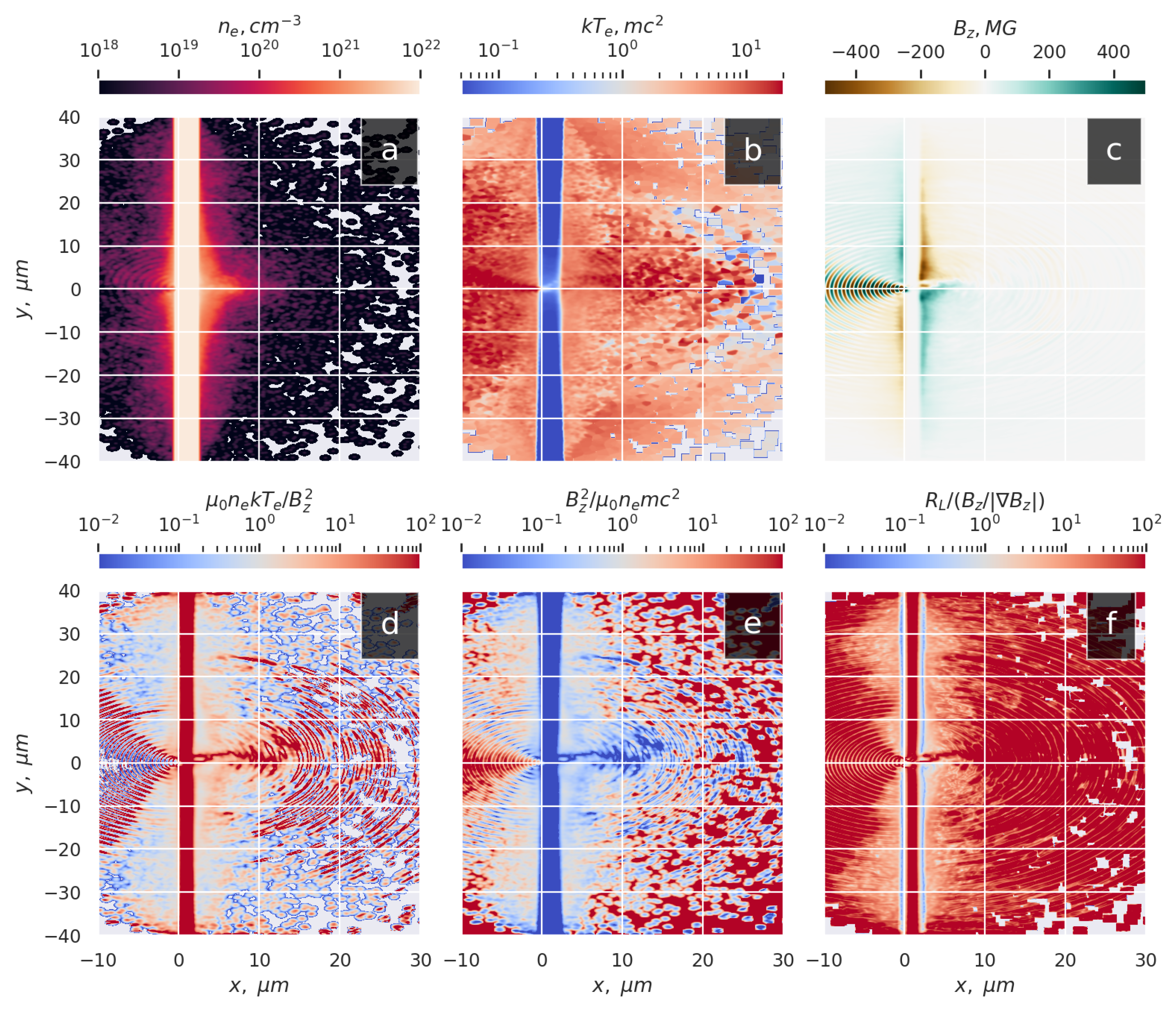Generation of Cold Magnetized Relativistic Plasmas at the Rear of Thin Foils Irradiated by Ultra-High-Intensity Laser Pulses
Abstract
1. Introduction
2. Methods
3. Results
4. Discussion
Funding
Data Availability Statement
Conflicts of Interest
References
- Remington, B.; Drake, R.; Ryutov, D. Experimental astrophysics with high power lasers and Z pinches. Rev. Mod. Phys. 2006, 78, 755–807. [Google Scholar] [CrossRef]
- Bulanov, S.V.; Esirkepov, T.Z.; Kando, M.; Koga, J.; Kondo, K.; Korn, G. On the problems of relativistic laboratory astrophysics and fundamental physics with super powerful lasers. Plasma Phys. Rep. 2015, 41, 1–51. [Google Scholar] [CrossRef]
- Nilson, P.M.; Willingale, L.; Kaluza, M.C.; Kamperidis, C.; Minardi, S.; Wei, M.S.; Fernandes, P.; Notley, M.; Bandyopadhyay, S.; Sherlock, M.; et al. Magnetic Reconnection and Plasma Dynamics in Two-Beam Laser-Solid Interactions. Phys. Rev. Lett. 2006, 97, 255001. [Google Scholar] [CrossRef] [PubMed]
- Fox, W.; Bhattacharjee, A.; Germaschewski, K. Fast Magnetic Reconnection in Laser-Produced Plasma Bubbles. Phys. Rev. Lett. 2011, 106, 215003. [Google Scholar] [CrossRef]
- Fiksel, G.; Fox, W.; Bhattacharjee, A.; Barnak, D.H.; Chang, P.Y.; Germaschewski, K.; Hu, S.X.; Nilson, P.M. Magnetic Reconnection between Colliding Magnetized Laser-Produced Plasma Plumes. Phys. Rev. Lett. 2014, 113, 105003. [Google Scholar] [CrossRef] [PubMed]
- Rosenberg, M.J.; Li, C.K.; Fox, W.; Zylstra, A.B.; Stoeckl, C.; Séguin, F.H.; Frenje, J.A.; Petrasso, R.D. Slowing of Magnetic Reconnection Concurrent with Weakening Plasma Inflows and Increasing Collisionality in Strongly Driven Laser-Plasma Experiments. Phys. Rev. Lett. 2015, 114, 205004. [Google Scholar] [CrossRef]
- Matteucci, J.; Fox, W.; Bhattacharjee, A.; Schaeffer, D.B.; Moissard, C.; Germaschewski, K.; Fiksel, G.; Hu, S.X. Biermann-Battery-Mediated Magnetic Reconnection in 3D Colliding Plasmas. Phys. Rev. Lett. 2018, 121, 095001. [Google Scholar] [CrossRef] [PubMed]
- Lyubarsky, Y.E. On the relativistic magnetic reconnection. Mon. Not. R. Astron. Soc. 2005, 358, 113–119. [Google Scholar] [CrossRef]
- Raymond, A.E.; Dong, C.F.; McKelvey, A.; Zulick, C.; Alexander, N.; Bhattacharjee, A.; Campbell, P.T.; Chen, H.; Chvykov, V.; Del Rio, E.; et al. Relativistic-electron-driven magnetic reconnection in the laboratory. Phys. Rev. E 2018, 98, 043207. [Google Scholar] [CrossRef]
- Mourou, G.; Tajima, T.; Bulanov, S. Optics in the relativistic regime. Rev. Mod. Phys. 2006, 78, 309–371. [Google Scholar] [CrossRef]
- Law, K.F.F.; Abe, Y.; Morace, A.; Arikawa, Y.; Sakata, S.; Lee, S.; Matsuo, K.; Morita, H.; Ochiai, Y.; Liu, C.; et al. Relativistic magnetic reconnection in laser laboratory for testing an emission mechanism of hard-state black hole system. Phys. Rev. E 2020, 102, 033202. [Google Scholar] [CrossRef] [PubMed]
- Gu, Y.J.; Klimo, O.; Kumar, D.; Bulanov, S.V.; Esirkepov, T.Z.; Weber, S.; Korn, G. Fast magnetic field annihilation driven by two laser pulses in underdense plasma. Phys. Plasmas 2015, 22, 103113. [Google Scholar] [CrossRef]
- Gu, Y.J.; Yu, Q.; Klimo, O.; Esirkepov, T.Z.; Bulanov, S.V.; Weber, S.; Korn, G. Fast magnetic energy dissipation in relativistic plasma induced by high order laser modes. High Power Laser Sci. Eng. 2016, 4, e19. [Google Scholar] [CrossRef][Green Version]
- Gu, Y.J.; Klimo, O.; Kumar, D.; Liu, Y.; Singh, S.K.; Esirkepov, T.Z.; Bulanov, S.V.; Weber, S.; Korn, G. Fast magnetic-field annihilation in the relativistic collisionless regime driven by two ultrashort high-intensity laser pulses. Phys. Rev. E 2016, 93, 013203. [Google Scholar] [CrossRef] [PubMed]
- Gu, Y.J.; Bulanov, S.S.; Korn, G.; Bulanov, S.V. Splitter target for controlling magnetic reconnection in relativistic laser plasma interactions. Plasma Phys. Control. Fusion 2018, 60, 044020. [Google Scholar] [CrossRef]
- Gu, Y.J.; Pegoraro, F.; Sasorov, P.V.; Golovin, D.; Yogo, A.; Korn, G.; Bulanov, S.V. Electromagnetic Burst Generation during Annihilation of Magnetic Field in Relativistic Laser-Plasma Interaction. Sci. Rep. 2019, 9, 19462. [Google Scholar] [CrossRef]
- Gu, Y.J.; Bulanov, S.V. Magnetic field annihilation and charged particle acceleration in ultra-relativistic laser plasmas. High Power Laser Sci. Eng. 2021, 9, e2. [Google Scholar] [CrossRef]
- Yi, L.; Shen, B.; Pukhov, A.; Fülöp, T. Relativistic magnetic reconnection driven by a laser interacting with a micro-scale plasma slab. Nat. Commun. 2018, 9, 1601. [Google Scholar] [CrossRef] [PubMed]
- Brunel, F. Anomalous absorption of high intensity subpicosecond laser pulses. Phys. Fluids 1988, 31, 2714–2719. [Google Scholar] [CrossRef]
- Mulser, P.; Weng, S.M.; Liseykina, T. Analysis of the Brunel model and resulting hot electron spectra. Phys. Plasmas 2012, 19, 043301. [Google Scholar] [CrossRef]
- Liseykina, T.; Mulser, P.; Murakami, M. Collisionless absorption, hot electron generation, and energy scaling in intense laser-target interaction. Phys. Plasmas 2015, 22, 033302. [Google Scholar] [CrossRef]
- Wilks, S.C.; Langdon, A.B.; Cowan, T.E.; Roth, M.; Singh, M.; Hatchett, S.; Key, M.H.; Pennington, D.; MacKinnon, A.; Snavely, R.A. Energetic proton generation in ultra-intense laser-solid interactions. Phys. Plasmas 2001, 8, 542–549. [Google Scholar] [CrossRef]
- Robinson, A.P.L.; Foster, P.; Adams, D.; Carroll, D.C.; Dromey, B.; Hawkes, S.; Kar, S.; Li, Y.T.; Markey, K.; McKenna, P.; et al. Spectral modification of laser-accelerated proton beams by self-generated magnetic fields. New J. Phys. 2009, 11, 083108. [Google Scholar] [CrossRef]
- Nakatsutsumi, M.; Sentoku, Y.; Korzhimanov, A.; Chen, S.N.; Buffechoux, S.; Kon, A.; Atherton, B.; Audebert, P.; Geissel, M.; Hurd, L.; et al. Self-generated surface magnetic fields inhibit laser-driven sheath acceleration of high-energy protons. Nat. Commun. 2018, 9, 280. [Google Scholar] [CrossRef] [PubMed]
- Huang, H.; Zhang, Z.M.; Zhang, B.; Hong, W.; He, S.K.; Meng, L.B.; Qi, W.; Cui, B.; Zhou, W.M. Investigation of magnetic inhibition effect on ion acceleration at high laser intensities. Matter Radiat. Extrem. 2021, 6, 044401. [Google Scholar] [CrossRef]
- Surmin, I.A.; Bastrakov, S.I.; Efimenko, E.S.; Gonoskov, A.A.; Korzhimanov, A.V.; Meyerov, I.B. Particle-in-Cell laser-plasma simulation on Xeon Phi coprocessors. Comput. Phys. Commun. 2016, 202, 204–210. [Google Scholar] [CrossRef]
- Gurevich, A.V.; Pariiskaya, L.V.; Pitaevskii, L.P. Self-similar motion of rarefied plasma. Sov. Phys. JETP 1966, 22, 449–454. [Google Scholar]
- Mora, P.; Pellat, R. Self-similar expansion of a plasma into a vacuum. Phys. Fluids 1979, 22, 2300–2304. [Google Scholar] [CrossRef]
- Hakobyan, H.; Philippov, A.; Spitkovsky, A. Effects of Synchrotron Cooling and Pair Production on Collisionless Relativistic Reconnection. Astrophys. J. 2019, 877, 53. [Google Scholar] [CrossRef]
- Hakobyan, H.; Petropoulou, M.; Spitkovsky, A.; Sironi, L. Secondary Energization in Compressing Plasmoids during Magnetic Reconnection. Astrophys. J. 2021, 912, 48. [Google Scholar] [CrossRef]





Publisher’s Note: MDPI stays neutral with regard to jurisdictional claims in published maps and institutional affiliations. |
© 2021 by the author. Licensee MDPI, Basel, Switzerland. This article is an open access article distributed under the terms and conditions of the Creative Commons Attribution (CC BY) license (https://creativecommons.org/licenses/by/4.0/).
Share and Cite
Korzhimanov, A.V. Generation of Cold Magnetized Relativistic Plasmas at the Rear of Thin Foils Irradiated by Ultra-High-Intensity Laser Pulses. Appl. Sci. 2021, 11, 11966. https://doi.org/10.3390/app112411966
Korzhimanov AV. Generation of Cold Magnetized Relativistic Plasmas at the Rear of Thin Foils Irradiated by Ultra-High-Intensity Laser Pulses. Applied Sciences. 2021; 11(24):11966. https://doi.org/10.3390/app112411966
Chicago/Turabian StyleKorzhimanov, Artem V. 2021. "Generation of Cold Magnetized Relativistic Plasmas at the Rear of Thin Foils Irradiated by Ultra-High-Intensity Laser Pulses" Applied Sciences 11, no. 24: 11966. https://doi.org/10.3390/app112411966
APA StyleKorzhimanov, A. V. (2021). Generation of Cold Magnetized Relativistic Plasmas at the Rear of Thin Foils Irradiated by Ultra-High-Intensity Laser Pulses. Applied Sciences, 11(24), 11966. https://doi.org/10.3390/app112411966





